A team of paleontologists in India have given 256 fossilized dinosaur eggs a close look, in hopes of better understanding how some of the largest known dinosaurs bred and hatched.
The eggs were found across 92 titanosaur nesting sites in India’s Narmada Valley, north and east of Mumbai, with the first clutches discovered in 2012. Now, researchers have published insights about the types of fossilised eggs found in these nests, along with inferences about the dinosaurs that laid them. The team’s research is published today in PLoS ONE.
Harsha Dhiman, the study’s lead author, said in a PLoS release that the research “offers new insights into the conditions of nest preservation and reproductive strategies of titanosaur sauropod dinosaurs just before they went extinct.”
For one, the researchers know the eggs were laid by titanosaurs, a group of sauropods that includes some of the largest dinosaurs to ever roam Earth. They identified eggs of the genera Megaloolithus and Fusioolithus — the titanosaur groups known to have lived in India.
Elements of the sandstone in which the eggs were preserved suggest to the researchers that, when the eggs were laid, the marshy environment had some flowing water; perhaps the nesting site was near a Cretaceous pond or lake.
The eggs came in many shapes and sizes. Some were complete eggs. Some were shattered into fossilised, roughly 67-million-year-old eggshells. Still others were deformed, compressed, or mere outlines of eggs in the sandstone.
Some of the finds were pathological eggs, an abnormal variety produced when animals are stressed. Some of the abnormal occurrences the team found were eggs with multiple shell layers or eggs forming within other eggs. These types of abnormalities also occur in modern birds (which you may have found yourself, if you ever cracked open eggs to find a double yolk).

Besides conjuring the idea of a double-yolked titanosaur omelet (was I the only one thinking about that?), the pathological eggs indicate titanosaurs may have produced eggs sequentially, like modern birds.
Despite the abundance of fossilised eggshells and nests, the team found nary a dinosaur. Meaning for all the eggs, no dinosaur bodies — from hatched young all the way up to the full-size titanosaurs — were found in the vicinity of the nesting sites.
“From a theoretical point of view, it could be possible that this area was only for nesting and not for habitation purposes,” wrote Guntupalli Prasad, a paleontologist at the University of Delhi in India, in an email to Gizmodo. “From a taphonomic (preservation) point of view the bones could not get preserved, or are deeply buried or still unexposed and yet to be discovered.”
Even without titanosaur bones, the sites are shedding light on dinosaur reproductive biology, a field that we still don’t know too much about. Next, the team plans to revisit the nesting sites and look for titanosaur teeth. They’ll also take CT scans of some of the more complete eggs to see if embryonic skeletons are preserved.
More: At Long Last, Paleontologists Scrutinise a Dinosaur Cloaca
